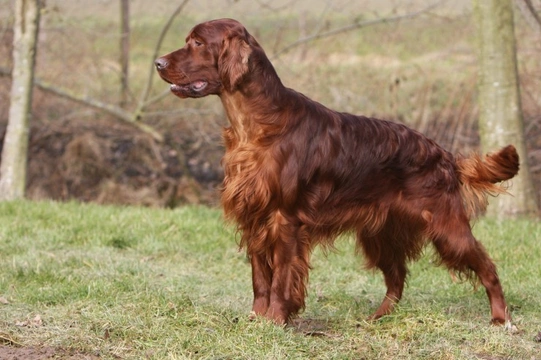
Progressive Retinal Atrophy (PRA-rcd 1) testing in Irish setters
Progressive retinal atrophy is one of the best known and widely disseminated canine health conditions that can affect the eyes, and whilst it is reasonably well understood, it cannot be prevented, cured or reversed. Ultimately it leads to a gradual and full blindness in affected dogs, which is not painful but does of course cause a fairly significant negative impact on their quality of life.
It is a hereditary condition that is passed on from parent dogs to their offspring, and cannot be passed from dog to dog in any other way.
As the condition cannot be reversed, prevented or cured, the only way to prevent the condition’s spread and its impact on an ever-widening number of dogs is by means of genetic testing, and then removing dogs that are carriers for the condition (or affected by it themselves) from the gene pool by making a decision to not breed from them.
There are a large number of different types of progressive retinal atrophy, each of which is caused by a different faulty gene. Whilst all variants of the condition work in the same way and have the same end result-eventual blindness-in order to find out if a dog is carrying any given form of the condition, a specific test must be performed to find it, as there is not one lone test that identifies every variant of the condition.
Testing for the different types of progressive retinal atrophy is performed by means of DNA testing, and having this test performed is important for owners of at-risk breeds that plan to use their dogs for breeding, and also potentially for dog owners who want to know what to expect in the future from their own dog’s eye health.
In this article, we will look at the RCD1 variant of progressive retinal atrophy, which most commonly affects the Irish setter dog breed. Read on to learn more.
What is progressive retinal atrophy RCD1?
For more general information on progressive retinal atrophy and how it affects dogs, check out our previous article here.
RCD1 is one of the forms of progressive retinal atrophy that affects the eye’s cones and rods, which are the parts of the retina that receive light and colour, and transmit this information to the brain where it becomes the picture that your dog sees of the world around them.
Whilst some types of progressive retinal atrophy do not begin to affect the dog until they are adult, or in some cases, have reached old age, RCD1 is an early-onset form of the condition, which works by beginning to destroy the dog’s photoreceptor cells from as early as just ten days old, when the dogs will only just be beginning to open their eyes and see for the first time.
The progression from the early stages of the disease to it causing total blindness can take up to a year to complete.
What sort of dogs are affected by the condition?
The RCD1 form of progressive retinal atrophy is most prevalent within the Irish setter dog breed, which means that dogs from that breed are at risk of inheriting the condition due to its prevalence in the gene pool, as are cross breed dogs with some Irish setter ancestry.
As an early onset form of progressive retinal atrophy, RCD1 usually becomes apparent in dogs that will develop the condition by the time they are one year old, and it is much less common to see the disease begin to become symptomatic in older dogs.
How does the heredity of the condition work?
Progressive retinal atrophy RCD1 is an autosomal recessive condition, which means that different combinations of inherited copies of the responsible gene from each parent have different impacts on their litter.
If both parent dogs are affected with the condition, all of their offspring will be too. If both parents are clear, all of the puppies will be clear.
If one of the dogs carries the gene for the condition but is not affected by it whilst the other is clear, 50% of their offspring will be clear, and 50% carriers. If both parents are carriers, 50% of their puppies will be carriers, 25% clear, and 25% affected.
If one parent dog is clear and one affected, all of the puppies will carry the condition but not be symptomatic. If one parent is a carrier and the other affected, half of the pups will be affected and half carriers.
If both parent dogs are affected by the condition, so too will all of their offspring.
How can I get my dog tested for RCD1 progressive retinal atrophy?
In order to get your dog tested for the RCD1 variant of progressive retinal atrophy, you will just need to ask your vet to take a cheek swab from your dog, which is then sent off to a laboratory for DNA testing. For a list of the laboratories in the UK can that carry out the test, check out this list on The Kennel Club’s website.



